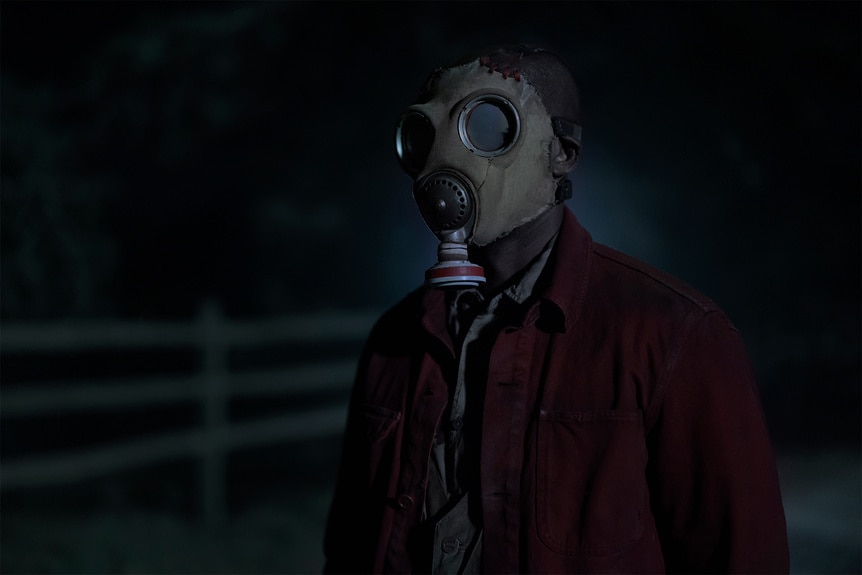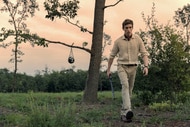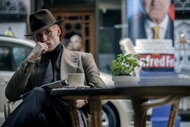Create a free profile to get unlimited access to exclusive videos, sweepstakes, and more!
The Grotesque, Real-Life Inspiration Behind Teacup's Most Shocking Visual
This is how you design dread.
Peacock’s new sci-fi thriller Teacup is based on the novel Stinger by Robert R. McCammon. It centers on a rural family and their neighbors, unwittingly locked in a conflict of cosmic proportions, when they find themselves stuck inside an invisible but very deadly trap.
Aside from that, the setting for Teacup couldn’t be any more down to Earth. It takes place on a remote Georgia farm, where the nearest neighbor is on the other side of a forest. The stakes are also fairly relatable, despite their otherworldly origin; everyone just wants to protect their own and get out alive. The mandate to keep one foot in the real world, even while telling a fantastical story, influenced even the effects design.
Novels have the benefit of the reader’s imagination to take care of the visualization, but adapting the story for the screen meant bringing every horrifying detail to life. So SYFY WIRE spoke with Carey Jones of KNB EFX Group about designing dread on Teacup.
Creating the horrifying visual effects of Peacock’s Teacup
“A lot of the prep was human anatomy, what’s inside, the layers [of the body], we looked at a lot of grotesque things. The general order was to stay grounded. There’s that Body Worlds thing with the bodies dissected and preserved in different layers, we used that as a reference. Because the idea is that the general makeup of the thing that crosses the line is still there, it’s just being reconstituted into something else. It needed to still look human, even after the change,” Jones told SYFY WIRE.
The line in question shows up in Teacup’s first episode, when a masked figure paints a blue line around the area and warns everyone inside not to cross it. It’s the sort of warning you might rightly ignore, except that a wild dog thrown over the line instantly begins twisting and contorting, its own flesh and bones rearranging themselves into a deadly configuration. Jones and team couldn’t add anything new to the dog or to anything else that crossed the line. Every creation had to be made of the sinew, bones, and flesh available.
Series creator Ian McCulloch provided a bible describing how he wanted the world of Teacup to look, and the effects team came back with a spectrum of ideas. Some of those ideas were within the guidelines set out by McCulloch, and some of them intentionally stepped outside those boundaries. Jones remarked that sometimes you don’t really know what you want until you see what you don’t want, and that by providing a wide range of options and working together with McCulloch, they zeroed in on the show’s twisted aesthetic. “We did, I don’t know, 50 sketches for every character and item we had to create. Some were pretty outlandish, they were great, but they were pretty far out there,” Jones said.
All of that forethought, planning, and care shines through in the end result. In fact, there’s more going on in Teacup’s distorted victims than you might immediately realize. The way a person or animal is contorted tells you something about the trap and how it works. As a living organism crosses the line, the force of the trap pulls them back toward it. As the body reorders itself into its final bloody shape, it points back toward the trap, like a warning.
“Establishing motion was very important, it tells the story of what happened before they crossed the line. It’s frozen in time,” Jones said. Achieving that level of implied motion in an unmoving statue was the result of intense collaboration between individuals, teams, and departments. Often, different parts of the statues, wearable prosthetics, and other physical effects were being completed by separate teams, and all of those pieces needed to come together to sell the story.
“It all has to be seamless, with effects augmentation, with lighting, you have to have those conversations all the way through or else it won’t come together. We had to make sure, when the actress was doing her motions, that her final position could match the statue. If the statue was contorted in a position she couldn’t get into then there’d be a whole phase in there you would miss,” Jones said. “It’s about communicating, it’s about understanding other technical trades and communication between stunt, actors, lighting, camera, the director, the show runner; it’s a constant dance.”
Catch new episodes of Teacup every Thursday, only on Peacock.































